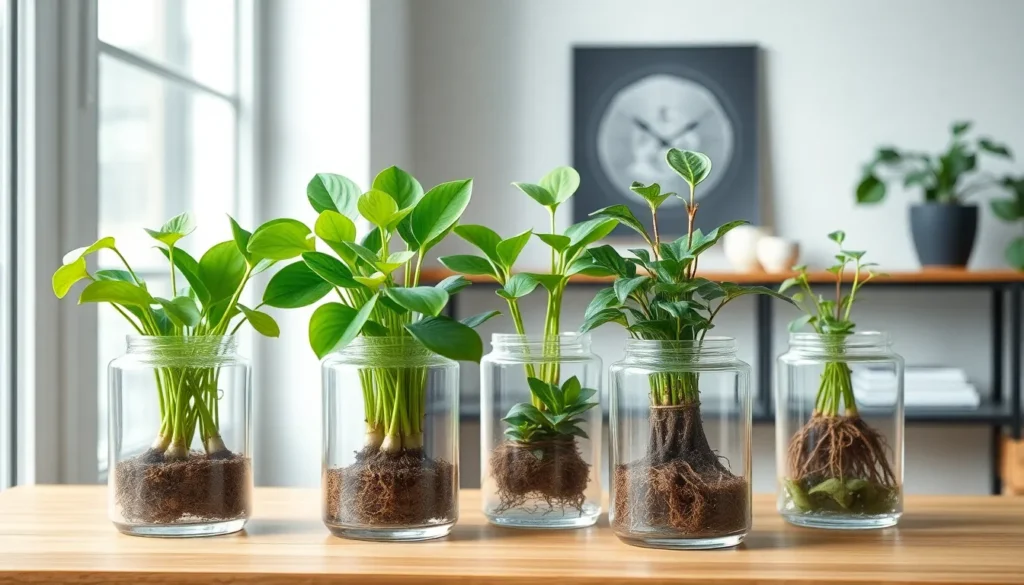Glass pots for plants have revolutionized the way we display our beloved greenery. These transparent containers aren’t just trendy – they’re practical vessels that transform any space into a sophisticated botanical showcase. We’ve discovered that glass planters offer unique benefits you won’t find with traditional ceramic or plastic options.
What makes glass pots so appealing? They allow us to witness the complete lifecycle of our plants including root development and soil layers. This transparency creates an educational experience that’s particularly captivating for children and plant enthusiasts alike. Plus glass containers complement virtually any décor style from minimalist modern to rustic farmhouse.
We’ll explore everything you need to know about choosing caring for and styling glass plant containers. Whether you’re a seasoned gardener or just starting your plant parent journey these versatile vessels offer endless possibilities for creating stunning indoor gardens that become conversation starters in any room.
Benefits of Using Glass Pots for Plants
Glass pots transform plant care into an captivating visual experience while offering practical advantages that traditional containers simply can’t match. We’ve discovered that these transparent vessels provide unique benefits that enhance both plant health and home aesthetics.
Enhanced Root Visibility for Better Plant Care
Monitoring root development becomes effortless when you can observe the entire root system through clear glass walls. We can identify potential issues like root rot, overcrowding, or nutrient deficiencies before they become serious problems. Tracking water absorption patterns helps us understand exactly when our plants need moisture, eliminating the guesswork that often leads to overwatering or underwatering.
Observing root growth cycles provides valuable insights into plant health and seasonal changes. We notice how roots respond to different fertilizers, lighting conditions, and care routines through direct visual feedback. Detecting pest issues early becomes possible when we can see tiny insects or larvae that might otherwise hide in soil around the root zone.
Superior Drainage Control and Water Management
Creating proper drainage systems in glass containers allows us to layer materials strategically for optimal water flow. We can add pebbles, activated charcoal, and specialized growing mediums in visible layers that serve both functional and decorative purposes. Preventing water stagnation becomes simpler when we can see exactly how much water remains at the bottom of the container.
Managing humidity levels improves significantly with glass pots since we can monitor condensation patterns on the container walls. We adjust watering schedules based on visible moisture indicators rather than relying on soil surface appearance alone. Controlling water quality becomes easier when we can observe how different water types affect root color and growth patterns.
Aesthetic Appeal and Modern Home Decor Integration
Showcasing plant beauty reaches new heights when roots, stems, and foliage create stunning visual displays in transparent containers. We can arrange multiple glass pots at varying heights to create ever-changing indoor gardens that serve as living art installations. Complementing interior design styles becomes effortless since glass containers blend seamlessly with minimalist, contemporary, and traditional decor themes.
Highlighting seasonal plant changes adds visual interest throughout the year as we watch bulbs emerge, roots expand, and growth patterns shift. We can coordinate glass pot collections with existing home accessories, lighting fixtures, and furniture pieces for cohesive room designs. Maximizing natural light distribution occurs when glass containers allow light to pass through and illuminate surrounding spaces while supporting healthy plant photosynthesis.
Types of Glass Pots for Plants Available
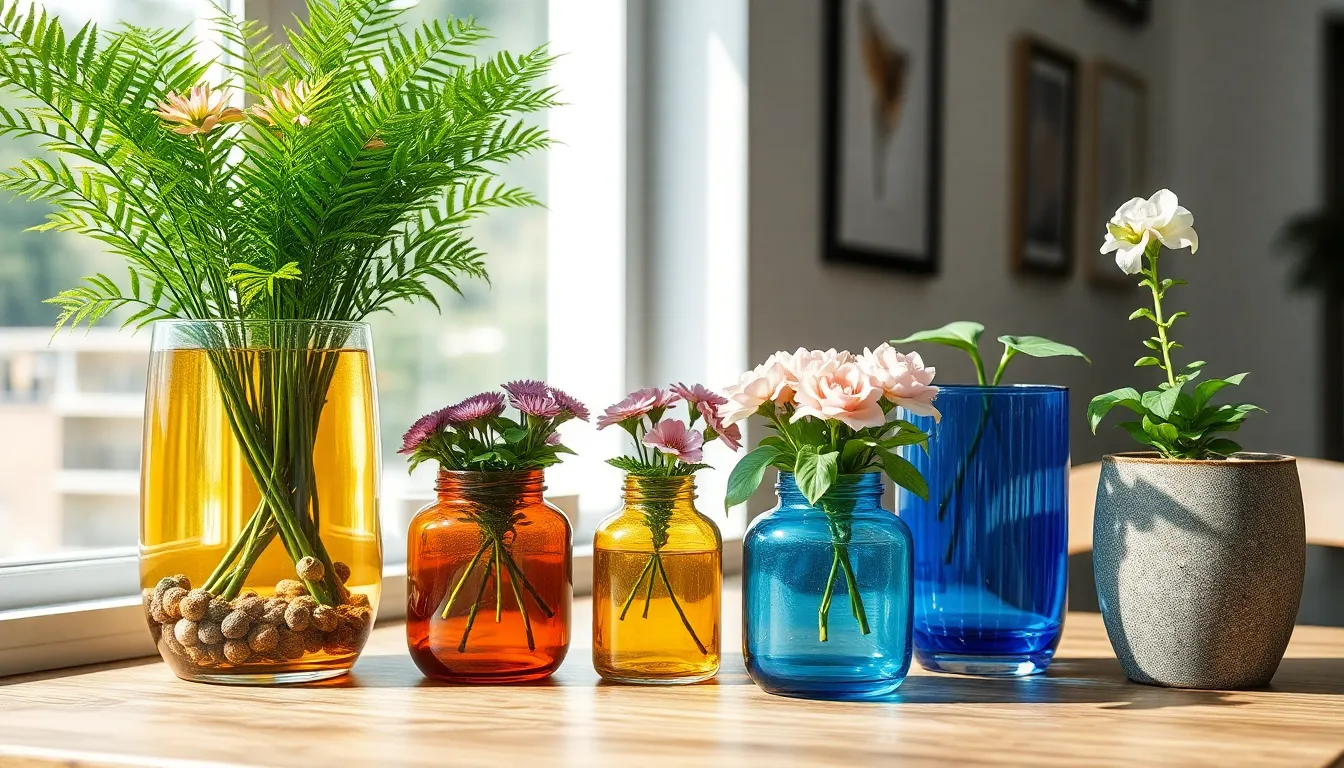
Different glass pot varieties cater to exact gardening needs and aesthetic preferences. We’ll explore three main categories that offer distinct advantages for your plant collection.
Clear Glass Planters for Maximum Light Exposure
Clear glass planters maximize sunlight penetration from all angles, promoting optimal photosynthesis for your plants. These transparent containers excel at supporting plants that require high light exposure while allowing you to observe complete root development. We recommend them particularly for terrariums and moisture-loving plants like ferns, where monitoring water levels and root health becomes essential.
Observation benefits make clear glass planters ideal for educational purposes and troubleshooting plant issues. Root growth patterns become visible, helping you identify when repotting is necessary or when root rot might be developing. Light-loving plants thrive in these containers since sunlight reaches every part of the root system.
Colored Glass Containers for Decorative Purposes
Colored glass containers transform plant displays into striking decorative elements that complement your interior design scheme. These vibrant pots add personality to any space while creating focal points that draw attention to your greenery. We find they work exceptionally well in modern and eclectic home styles where color coordination matters.
Design flexibility allows colored glass pots to match seasonal décor changes and existing color palettes. Blue and green tones create calming environments, while warmer colors like amber and red energize living spaces. Plants that adapt well to contained environments flourish in these decorative vessels.
Textured Glass Pots for Added Visual Interest
Textured glass pots introduce sophisticated surface patterns that create depth and visual complexity in your plant arrangements. These containers feature unique finishes like frosted, ribbed, or geometric patterns that diffuse light beautifully. We appreciate how they balance functionality with artistic appeal.
Surface variations catch and reflect light differently throughout the day, creating ever-changing visual effects. Root system visibility remains partially intact while adding an element of mystery to your plant display. Textured options work particularly well in minimalist settings where subtle details make important impact.
Best Plants to Grow in Glass Pots
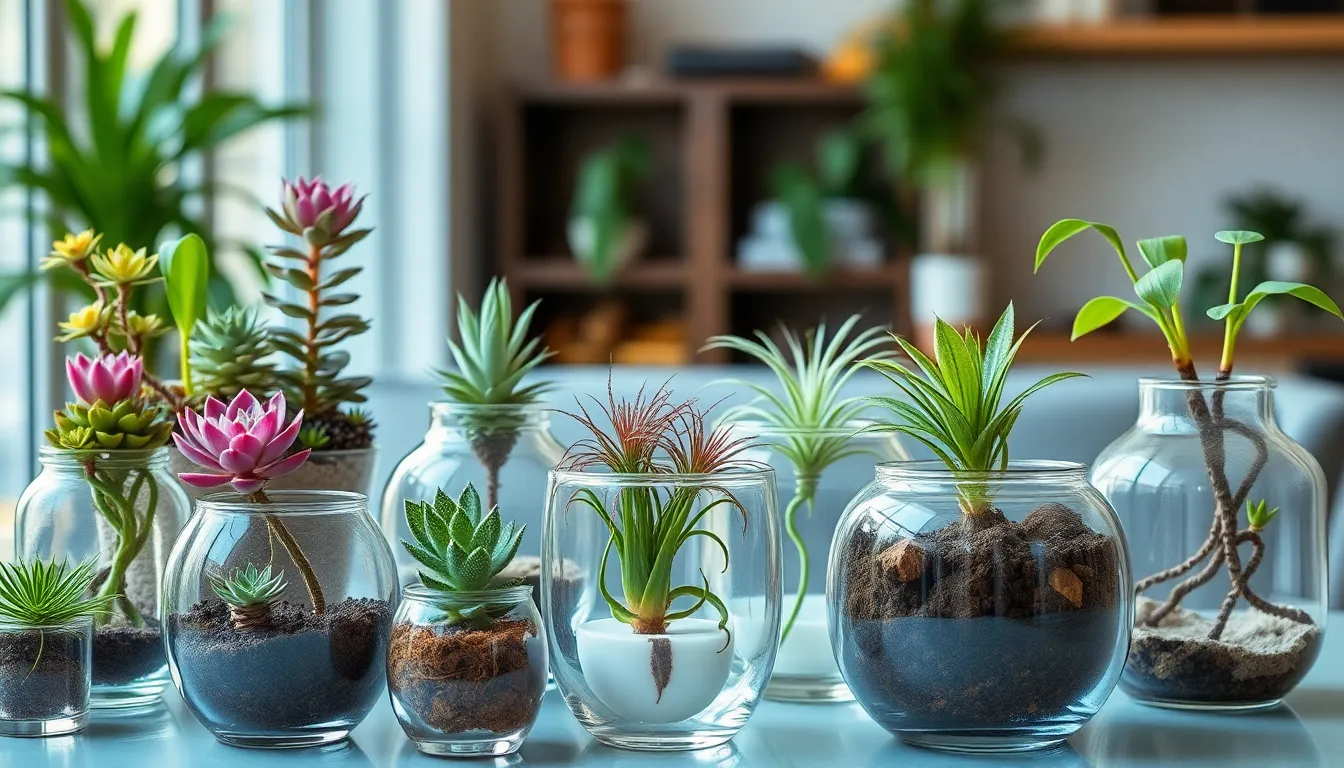
Selecting the right plants for your glass containers ensures both healthy growth and stunning visual displays. We’ve identified the most successful plant varieties that thrive in transparent containers while maximizing their decorative potential.
Succulents and Cacti for Low-Maintenance Options
Succulents and cacti excel in glass pots due to their hardy, drought-tolerant nature and minimal care requirements. These resilient plants adapt perfectly to glass containers because they typically don’t outgrow their space quickly and appreciate the well-draining conditions that glass pots provide. Popular varieties like Jade Plants and Aloe Vera maintain their compact form while thriving in the controlled environment of transparent containers.
We recommend succulents for busy plant parents who want beautiful displays without constant maintenance. Their ability to store water in thick, fleshy leaves means they can tolerate the precise watering control that glass pots offer. Cacti bring unique architectural shapes to your glass garden while requiring even less frequent care than traditional succulents.
The visual appeal of watching succulent roots develop through clear glass adds an educational element to your plant care routine. These plants demonstrate remarkable adaptability to glass environments, making them perfect starter choices for new glass pot enthusiasts.
Air Plants for Unique Display Opportunities
Air plants, scientifically known as Tillandsia, offer exceptional versatility for glass container displays because they require no soil whatsoever. These fascinating plants absorb moisture and nutrients directly through their specialized leaves, creating endless possibilities for creative arrangements in decorative glass bowls and jars. We find them particularly suited for minimalist or artistic displays that showcase their unique growing characteristics.
Care requirements for air plants in glass containers involve only occasional misting and placement in areas with indirect light. This simplicity makes them ideal for modern homes where low maintenance meets high visual impact. Their ability to thrive suspended in glass terrariums or nestled in glass bowls opens up three-dimensional design opportunities that soil-based plants cannot match.
Air plants transform ordinary glass containers into living sculptures that evolve over time. We appreciate how they allow complete creative freedom in arrangement since their root systems don’t anchor them to exact growing mediums.
Small Tropical Plants for Indoor Gardens
Small tropical plants create lush, vibrant displays in glass containers while bringing air-purifying benefits to indoor spaces. Pothos, commonly called Devil’s Ivy, stands out as particularly well-suited for glass pots because it propagates easily and can root directly in water or soil. Spider Plants offer excellent air purification qualities and adapt beautifully to both water and soil-based glass container systems.
Watermelon Peperomia brings striking patterned leaves that enhance the aesthetic appeal of any glass bowl arrangement. We’ve found that plants like Adanson’s Monstera and Radiator Plant adapt remarkably well to glass containers when provided with indirect light conditions. These tropical varieties create mini jungle environments that thrive in the controlled conditions glass pots provide.
The rapid growth and adaptability of these tropical species make them perfect for experimenting with different glass container styles and arrangements. Their diverse leaf patterns and growth habits ensure that your glass pot displays remain visually interesting throughout the seasons while contributing to healthier indoor air quality.
Proper Care and Maintenance of Glass Plant Containers
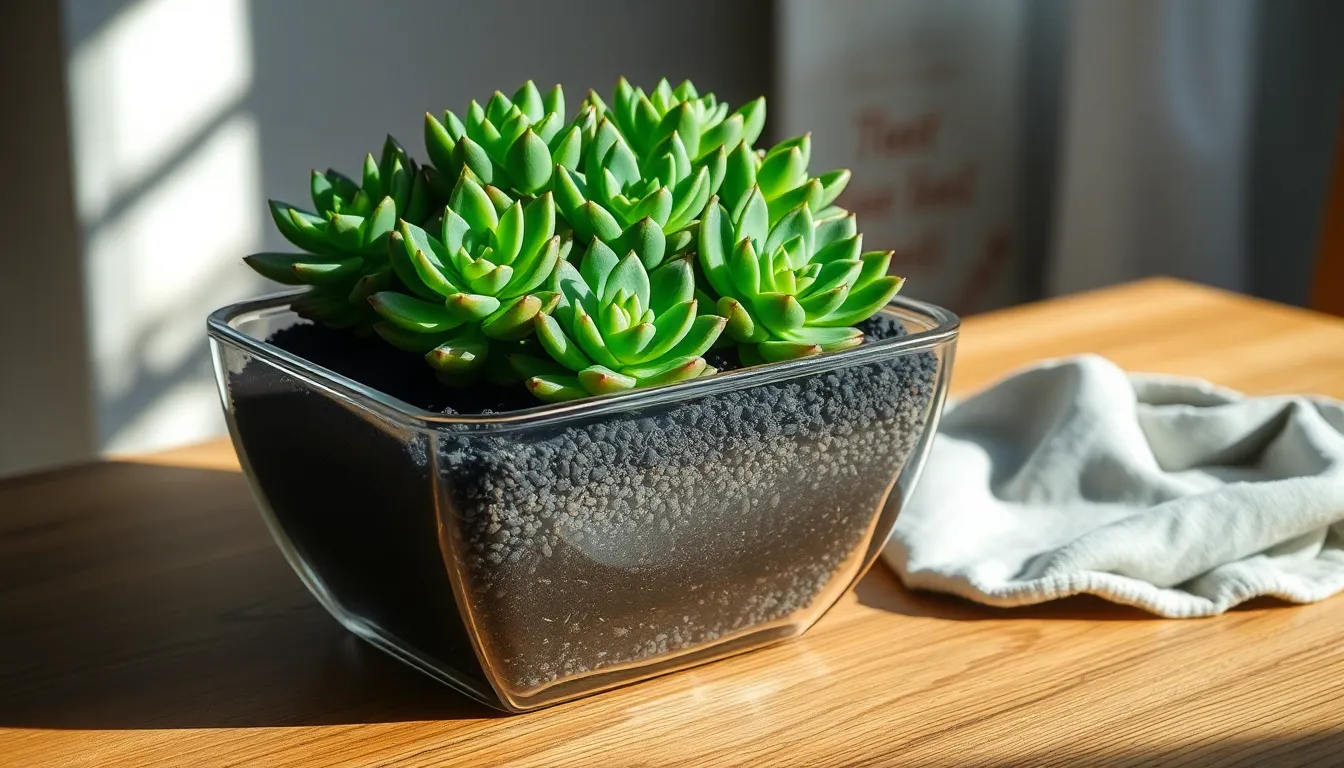
Glass plant containers require exact maintenance approaches to preserve their stunning visual appeal while ensuring optimal plant health. We’ll explore essential care techniques that keep your transparent planters functioning beautifully and your plants thriving.
Cleaning Techniques for Crystal Clear Visibility
Maintaining pristine glass surfaces enhances both aesthetic appeal and plant health by maximizing light penetration. We recommend starting with a thorough wash using soap and hot water before first use to eliminate residues and potential pathogens that could harm your plants.
Regular maintenance involves several key steps. Remove dead leaves and debris from both interior and exterior surfaces to prevent decay and maintain crystal clear visibility. Wipe the outside with a soft damp cloth while avoiding abrasive materials that scratch delicate glass surfaces.
Stubborn dirt requires gentle cleaning answers for effective removal without damage. Use mild soap or a vinegar water solution when standard cleaning methods aren’t sufficient. These natural cleaners effectively remove buildup while preserving the integrity of your glass containers.
Preventing Algae Growth in Transparent Containers
Algae thrives in glass containers due to the combination of light exposure and moisture creating ideal growing conditions. We focus on prevention strategies that address these environmental factors directly.
Overwatering creates the excess moisture that encourages algae development. Monitor soil moisture by checking with your finger up to the first knuckle and water only when dry to avoid this common issue.
Light management plays a crucial role in algae prevention strategies. Position your containers where they receive indirect light rather than intense direct sunlight which promotes algae proliferation. Incorporate a small layer of charcoal beneath the soil to help regulate moisture and inhibit both mold and algae growth.
Managing Moisture Levels Without Drainage Holes
Most glass pots lack drainage holes making moisture management critical for preventing waterlogging and root rot. We recommend creating artificial drainage systems using strategic layering techniques.
Layer charcoal or small stones at the bottom to improve drainage and absorb excess moisture effectively. Water sparingly while monitoring soil moisture frequently since it’s safer to underwater than overwater in containers without drainage.
Plant selection significantly impacts moisture management success in glass containers. Choose plants suited for closed or semi closed environments that thrive in high humidity with minimal watering requirements. Succulents and air plants in terrariums perform exceptionally well under these controlled conditions.
Use gentle watering methods such as watering cans with narrow spouts or spray bottles to control water delivery and avoid splashing leaves. For humidity loving plants regular misting or placing humidity trays nearby maintains proper moisture without creating waterlogged conditions.
Creative Display Ideas Using Glass Pots for Plants
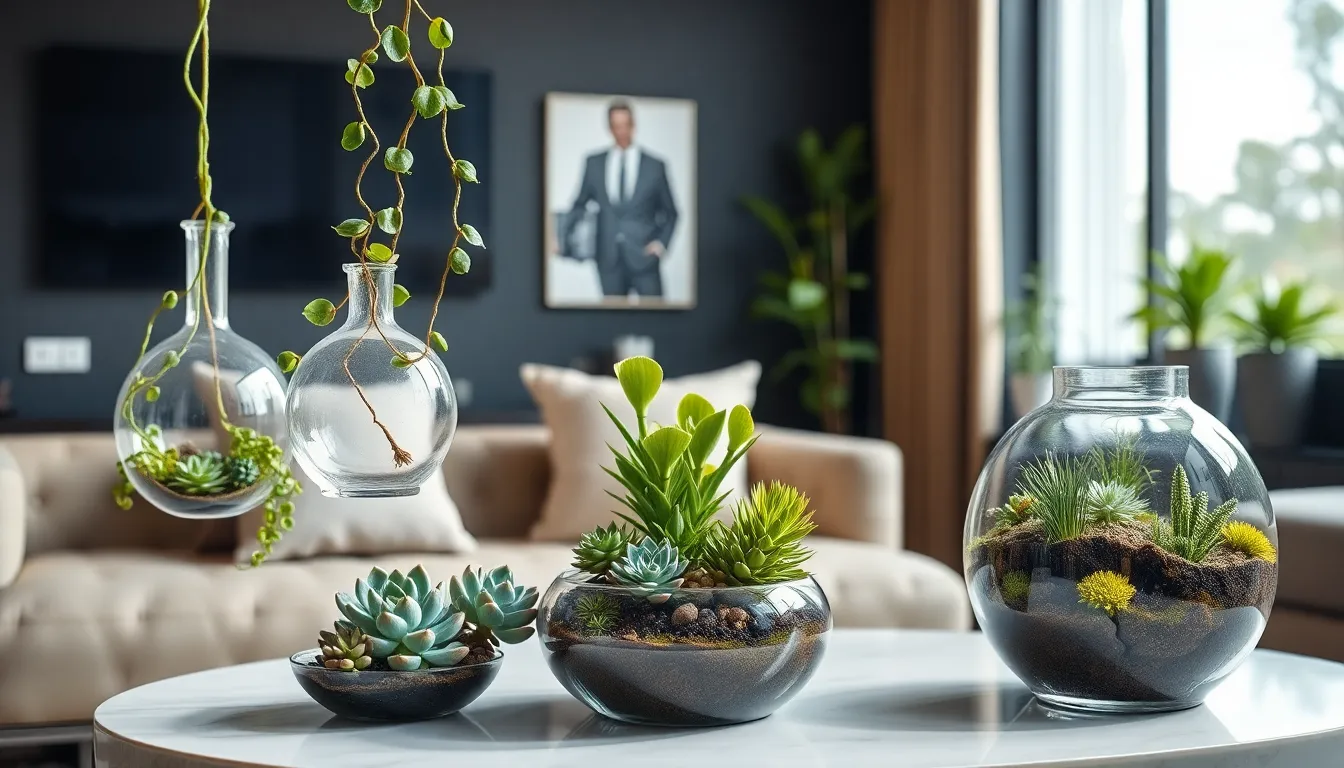
Glass pots offer endless creative possibilities that transform ordinary spaces into stunning botanical showcases. These transparent containers become art pieces that celebrate both plant life and interior design simultaneously.
Hanging Glass Planters for Vertical Gardens
Hanging glass planters maximize vertical space while creating an ethereal floating garden effect. Globe terrariums and geometric glass containers suspended by cords or metal frames work perfectly for this vertical approach. These elevated displays save valuable floor space while adding sophisticated dimension to any room.
Window placement allows these hanging gardens to capture maximum natural light throughout the day. Clustering them at different heights creates ever-changing visual interest that draws the eye upward. Air plants, trailing pothos, and small succulents thrive in these suspended environments where they can cascade naturally.
Metal macrame holders and sleek industrial chains provide sturdy support while complementing modern décor styles. We recommend spacing multiple hanging planters at varying lengths to avoid a uniform appearance that lacks visual depth.
Clustered Arrangements for Statement Pieces
Clustered glass pot arrangements create powerful focal points that command attention in any space. Grouping containers of varying sizes together emphasizes the beauty of botanical diversity while maintaining design cohesion. Coffee tables, console tables, and floating shelves provide ideal platforms for these eye catching displays.
Mixing plant varieties within clustered arrangements adds textural contrast and seasonal interest. Succulents paired with delicate ferns create striking oppositions while air plants add ethereal elements to the composition. Different glass shapes within the same grouping prevent monotony while maintaining visual harmony.
Decorative substrates like colored pebbles, preserved moss, and layered sand enhance each container’s individual appeal. These materials create distinct personalities for each pot while contributing to the overall aesthetic impact of the arrangement.
Terrarium-Style Setups for Miniature Ecosystems
Terrarium style glass pots create captivating miniature worlds that function as living dioramas. These enclosed or semi enclosed environments maintain ideal humidity levels for tropical plants, mosses, and delicate species that require consistent moisture. Layered soil systems with charcoal filtration and decorative rocks mimic natural forest floor conditions.
Closed glass containers develop their own water cycles where condensation creates rain like effects within the miniature network. Open terrarium designs allow for better air circulation while still maintaining higher humidity than traditional pots. These setups work particularly well for tropical plants that struggle in standard indoor conditions.
Educational value makes terrarium style arrangements perfect for families and plant enthusiasts who enjoy observing natural processes. Watching plants interact within their contained environments provides insights into ecological relationships and plant behavior patterns.
Where to Buy Quality Glass Pots for Plants
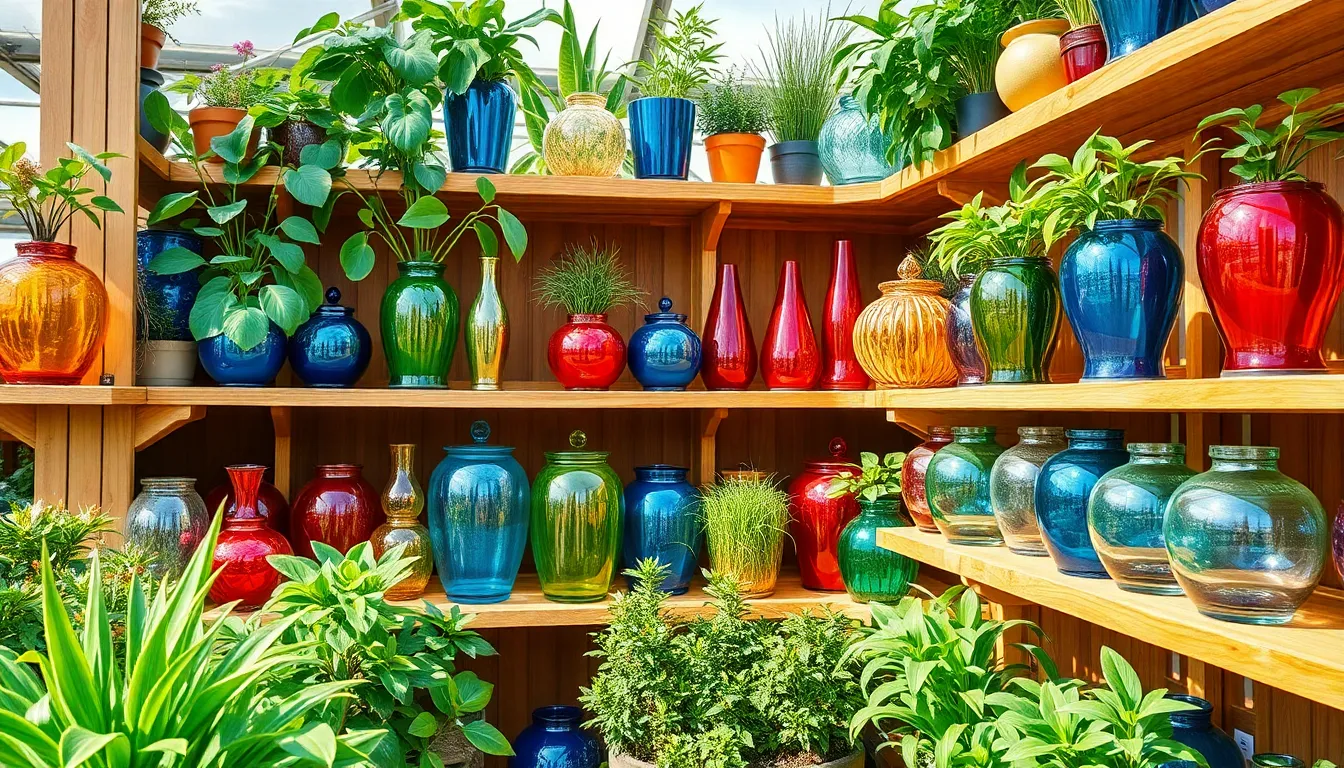
Finding the perfect glass containers for your plants has become easier than ever with many reliable sources available. We’ve compiled the best places to source quality glass pots that combine durability with aesthetic appeal.
Online Retailers with Extensive Selection
Amazon leads the online marketplace with thousands of glass pot options ranging from simple clear containers to decorative pieces with unique textures. Customer reviews help us make informed decisions, and Prime shipping ensures quick delivery for most glass planters.
Etsy showcases handcrafted glass pots from independent artisans worldwide, offering unique designs you won’t find elsewhere. Many sellers provide custom sizing and personalization options for their glass containers.
Specialty garden websites like Terrain and West Elm focus on curated collections of stylish glass pots that complement modern home decor. These platforms often feature seasonal collections and designer collaborations.
Wayfair offers competitive pricing on bulk glass pot purchases, making it ideal for creating multiple plant displays throughout your home. Their extensive filtering options help narrow down choices by size, color, and style.
Local Garden Centers and Nurseries
Independent nurseries typically stock glass pots alongside their plant collections, allowing us to see the containers in person before purchasing. Staff members can provide valuable advice on pairing exact plants with appropriate glass pot sizes.
Home improvement stores like Home Depot and Lowe’s carry basic glass planters in their garden sections, often at competitive prices. These locations offer the convenience of immediate availability without shipping delays.
Specialty plant shops in urban areas frequently feature curated selections of glass pots that complement their rare and exotic plant offerings. These stores often carry unique imported glass containers not found in larger retailers.
Specialty Home Decor and Plant Shops
Interior design boutiques combine plants with home decor, offering glass pots that serve as both functional planters and decorative accessories. These shops excel at helping customers select containers that match existing decor themes.
Create stores like Michaels and Hobby Lobby stock glass containers in their home decor sections, often featuring sales and coupons that make quality glass pots more affordable. Their selection includes both traditional and contemporary designs.
Farmers markets and local create fairs frequently feature artisans selling handblown glass pots with unique shapes and colors. These venues provide opportunities to support local artists while finding one of a kind pieces for your plant collection.
DIY Glass Pot Projects for Plant Enthusiasts
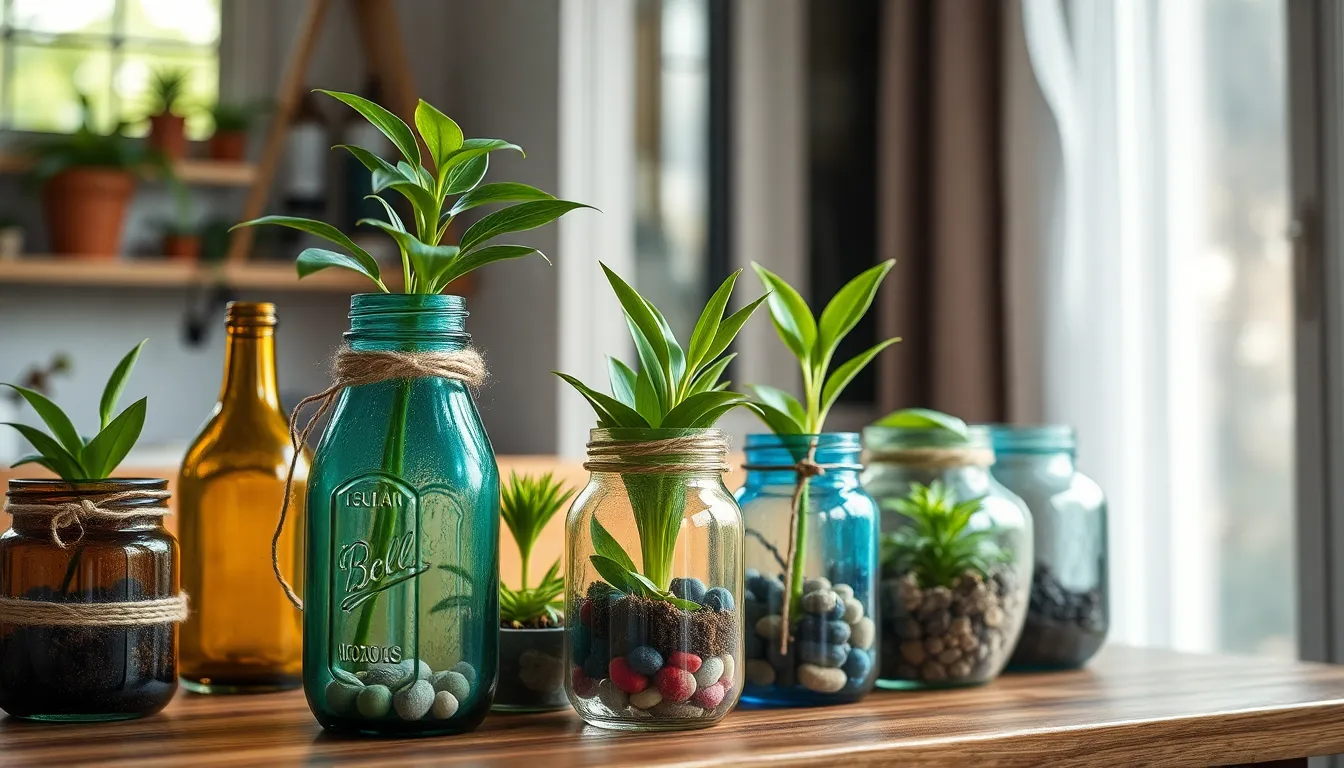
Creating stunning glass plant containers doesn’t require expensive purchases when you can create beautiful alternatives from everyday materials. We’ve discovered countless ways to transform ordinary glass items into extraordinary planters that rival store-bought options.
Repurposing Glass Containers for Plant Use
Mason jars offer perfect starting points for small plant displays, especially when you want to showcase herb gardens or propagation projects. We clean these containers thoroughly with soap and hot water before drilling drainage holes in the lids using a metal bit. Wine bottles become elegant vertical planters when cut carefully with a glass cutter, creating sleek containers ideal for air plants or small succulents.
Glass bowls from kitchen cabinets transform into stunning terrariums with minimal effort, providing wide openings that make plant arrangement simple. We’ve found that large pickle jars work exceptionally well for moisture-loving plants like ferns, while smaller baby food jars create charming displays for tiny cacti. Research shows that reusable glass materials mixed with soil improve water retention and reduce fungal growth compared to traditional pots, making recycled containers both eco-friendly and beneficial for plant health.
Yogurt containers and glass food storage jars need only proper cleaning and optional drainage modifications to become functional planters. We remove all labels using warm water and adhesive remover, then sand any sharp edges smooth for safety. These repurposed containers cost nothing while reducing household waste, making them perfect starter projects for new plant enthusiasts.
Decorating Plain Glass Pots with Creative Techniques
Paint transforms clear glass into vibrant statement pieces using specialized glass paints available at create stores. We apply base coats evenly with foam brushes, then add decorative patterns using stencils or freehand designs that complement our home décor. Etching cream creates frosted effects that add texture while maintaining some transparency for root observation.
Adhesive patterns using tape create geometric designs before painting, resulting in clean lines and professional-looking finishes. We’ve discovered that applying multiple thin coats produces better results than single thick applications, preventing drips and ensuring even coverage. Natural materials like twine, rope, or jute wrapped around containers add rustic charm while providing grip surfaces.
Glass markers offer temporary decoration options that wash away when you want design changes, making them perfect for seasonal displays. We use metallic leafing sheets with adhesive for elegant gold or silver accents that catch light beautifully. Decorative stones, colored sand, or moss glued to exterior surfaces create textured finishes that hide fingerprints while adding visual interest.
Spray paints designed for glass provide quick coverage for larger projects, though we always work in well-ventilated areas and use primer for better adhesion. Stenciling with contrasting colors creates sophisticated patterns that make plain containers look professionally designed.
Building Custom Glass Terrarium Systems
Glass panels from picture frames assemble into custom terrarium boxes using aquarium-safe silicone sealant for watertight joints. We cut panels to desired dimensions, then carefully seal edges while ensuring perfect alignment for professional results. These closed systems create ideal environments for tropical plants that thrive in high humidity conditions.
Large glass containers like fishbowls or apothecary jars provide ready-made terrarium bases requiring only proper layering systems. We start with pebble drainage layers, add activated charcoal for odor control, then place industry fabric before adding potting soil. This layering prevents water stagnation while maintaining proper moisture levels for plant roots.
Custom lighting systems using LED strips enhance plant growth while creating stunning visual displays during evening hours. We install battery-operated lights around terrarium perimeters or beneath glass shelves for dramatic uplighting effects. Ventilation becomes crucial in closed systems, so we incorporate small gaps or removable tops for air circulation control.
Temperature regulation in glass terrariums requires strategic placement away from direct sunlight and heating vents. We monitor internal conditions using small hygrometers and thermometers, adjusting plant selections based on environmental readings. These controlled ecosystems allow close observation of plant interactions and soil conditions while creating living art installations that evolve continuously.
Common Mistakes to Avoid with Glass Plant Containers
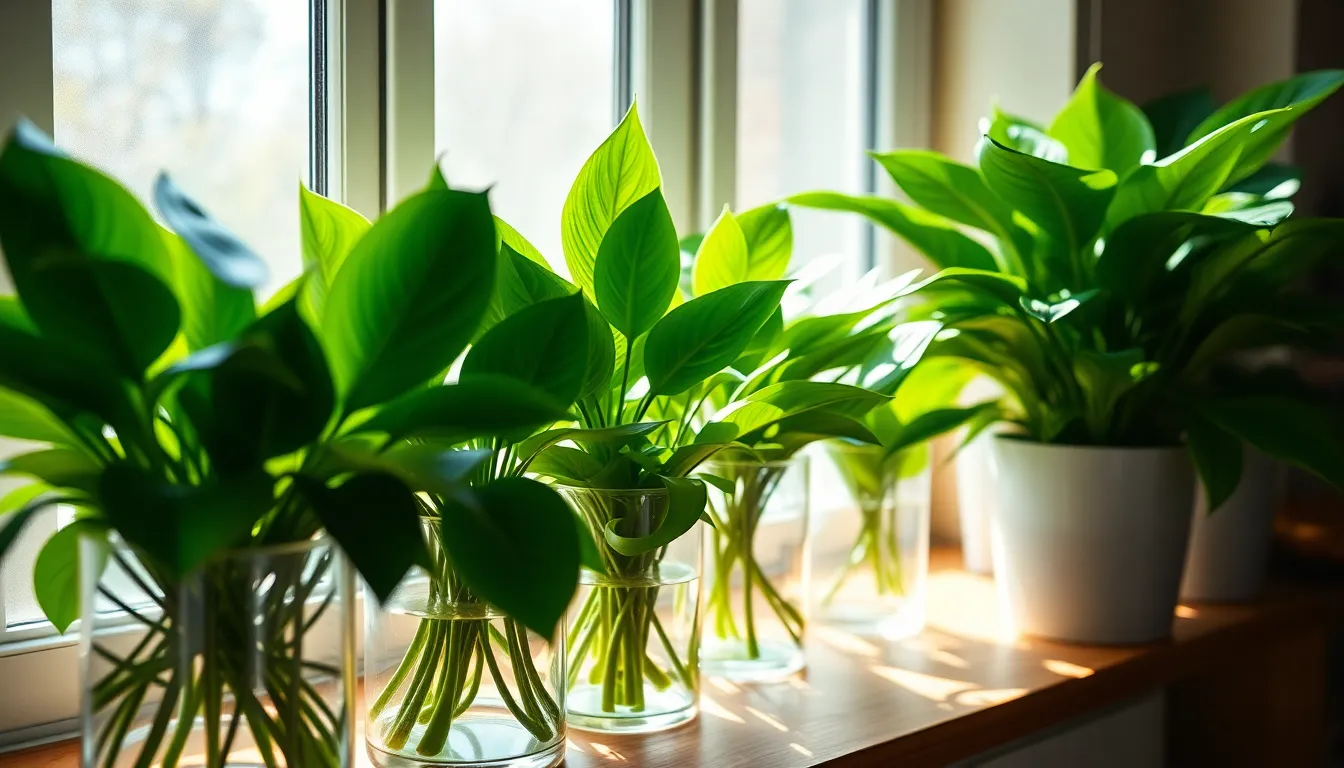
While glass pots offer many advantages for indoor gardening, certain mistakes can quickly turn your beautiful display into a plant care disaster. We’ve identified the most critical errors that beginners and experienced gardeners make when working with transparent containers.
Overwatering Issues in Non-Draining Pots
Trapped water becomes the silent killer of plants in glass containers without drainage holes. Most glass pots lack traditional drainage systems, creating perfect conditions for root rot when excess moisture accumulates at the bottom. Water sits stagnant in these containers, suffocating roots and encouraging dangerous fungal growth that can destroy your plants within weeks.
Creating artificial drainage layers helps prevent water accumulation disasters. We recommend placing pebbles or activated charcoal at the bottom of non-draining glass pots to improve aeration around the root zone. This simple technique allows excess water to settle below the soil line while maintaining proper moisture levels for healthy plant growth.
Watering sparingly becomes essential when drainage options are limited. Glass containers require a completely different watering approach compared to traditional pots with holes. We suggest using smaller amounts of water applied gradually, allowing the soil to absorb moisture slowly rather than saturating the entire container at once.
Placing Glass Pots in Direct Sunlight
Direct sunlight transforms glass containers into miniature greenhouses that can cook your plants alive. Glass materials amplify and concentrate sunlight, creating intense heat buildup inside the pot that can scorch delicate root systems. This greenhouse effect causes soil to dry out rapidly while simultaneously overheating the entire root zone, creating stress conditions that most plants cannot survive.
Root damage occurs when glass containers are exposed to prolonged bright light. We’ve observed that transparent materials allow sunlight to penetrate directly to the root system, an exposure that roots are not naturally designed to handle. Plants typically develop roots in dark soil environments, and sudden light exposure can cause permanent damage to these sensitive structures.
Indirect lighting positions protect plants while maintaining the aesthetic appeal of glass containers. We recommend placing glass pots in areas that receive bright but filtered light, such as near north-facing windows or in spots with natural shade during peak sun hours. This positioning allows plants to thrive while preventing the dangerous heat buildup that direct sunlight creates.
Choosing Inappropriate Plant Varieties
Drainage-dependent plants struggle dramatically in glass container environments. Succulents and cacti, even though their popularity, are generally poor choices for glass pots because they require extremely well-draining conditions that transparent containers cannot provide. These plants have evolved to thrive in arid conditions where excess moisture drains away immediately, making them incompatible with the higher humidity levels that glass containers naturally maintain.
Moisture-loving tropical plants adapt successfully to glass container conditions. We’ve found that plants like Pothos, Peace Lilies, and certain ferns thrive in the controlled humidity environment that glass pots create. These varieties naturally prefer consistent moisture levels and can tolerate the reduced drainage that characterizes most glass containers.
Matching plant requirements to container capabilities ensures long-term success. Before selecting plants for glass pots, we evaluate their water, light, and drainage preferences to ensure compatibility with transparent container conditions. Plants that prefer moderate to high humidity levels and can tolerate occasional moisture retention perform best in these specialized growing environments.
Conclusion
Glass pots offer a remarkable opportunity to elevate our indoor gardening experience while creating stunning visual displays. We’ve discovered that these transparent containers aren’t just beautiful—they’re practical tools that help us monitor plant health and create thriving ecosystems.
By choosing the right plants and following proper care techniques we can avoid common pitfalls and enjoy long-lasting success. Whether we’re displaying air plants in hanging terrariums or showcasing tropical varieties in colored containers the possibilities are endless.
The key lies in understanding our plants’ needs and matching them to the unique environment that glass pots provide. With proper selection and care these containers will transform our spaces into living art installations that bring joy for years to come.
Frequently Asked Questions
What are the main benefits of using glass pots for plants?
Glass pots offer enhanced root visibility for better plant health monitoring, superior drainage control through strategic layering, and exceptional aesthetic appeal. They create living art installations that complement various décor styles while allowing you to observe your plant’s complete lifecycle and identify issues like root rot early.
Which plants grow best in glass containers?
Succulents and cacti thrive in glass pots due to their drought tolerance and low maintenance needs. Air plants are perfect since they require no soil, while small tropical plants like Pothos and Spider Plants offer vibrant displays and air-purifying benefits in controlled glass environments.
How do I prevent algae growth in clear glass planters?
Control moisture levels and manage light exposure to prevent algae. Clean containers regularly with soap and hot water, avoid overwatering, and position glass pots in bright but filtered light rather than direct sunlight. Consider using activated charcoal in your drainage layer for additional algae prevention.
Can I use glass pots without drainage holes?
Yes, but create artificial drainage systems using layers of pebbles, activated charcoal, and appropriate soil. Choose moisture-loving plants that thrive in high humidity environments, and water carefully to prevent waterlogging. Monitor moisture levels closely and adjust watering frequency accordingly.
What’s the difference between clear, colored, and textured glass pots?
Clear glass maximizes light exposure and root visibility, ideal for educational purposes and moisture-loving plants. Colored glass serves as decorative elements that enhance interior design with vibrant hues. Textured glass offers sophisticated surface patterns while maintaining some root system visibility for minimalist settings.
Where can I buy quality glass plant containers?
Purchase from online retailers like Amazon and Etsy for extensive selections, specialty garden websites like Terrain and West Elm for curated collections, or local garden centers to see pots in person. Home improvement stores, craft stores like Michaels, and local farmers markets also offer diverse glass container options.
What are common mistakes to avoid with glass planters?
Avoid overwatering in non-draining pots, which causes root rot. Don’t place glass containers in direct sunlight as this creates a greenhouse effect that overheats roots. Choose appropriate plant varieties – moisture-loving tropical plants work best, while drainage-dependent plants like some succulents may struggle in glass containers.
How do I clean and maintain glass plant containers?
Use soap and hot water for regular cleaning to maintain crystal clear visibility. Establish routine maintenance practices to prevent decay and enhance aesthetics. Clean containers before replanting, remove any algae buildup promptly, and inspect for cracks or damage that could affect plant health.

